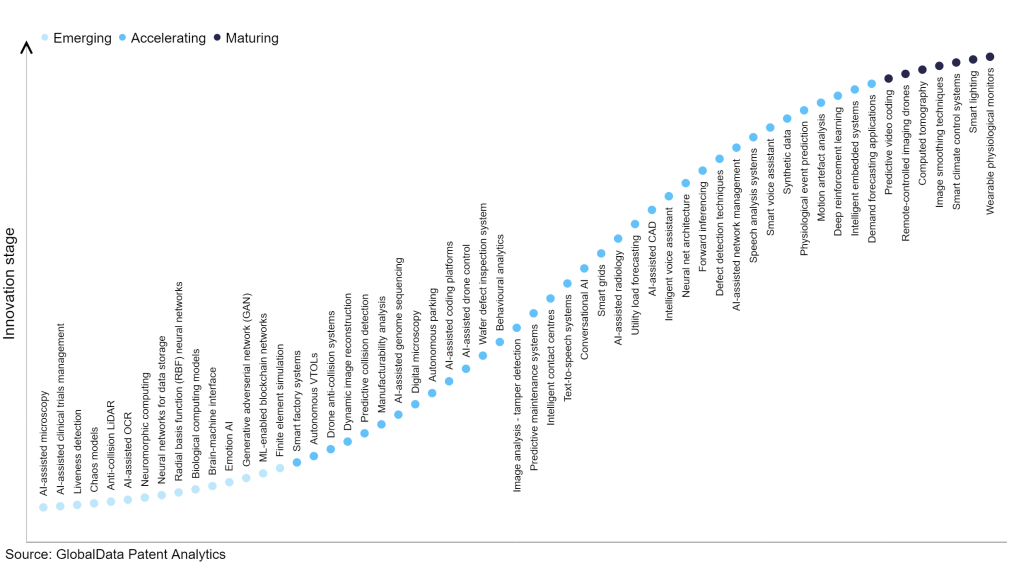The technology industry continues to be a hotbed of innovation, with activity driven by the amalgamation of technological progress, heightened connectivity, and the urgency for businesses to enhance efficiency and competitiveness in an ever-changing marketplace and growing importance of technologies such as advanced algorithms and machine learning techniques to identify patterns and predict outcomes, high-throughput sequencing technologies to rapidly sequence large amounts of DNA, and computational tools to interpret the resulting data. In the last three years alone, there have been over 3.6 million patents filed and granted in the technology industry, according to GlobalData’s report on Innovation in Artificial Intelligence: AI-assisted genome sequencing. Buy the report here.
However, not all innovations are equal and nor do they follow a constant upward trend. Instead, their evolution takes the form of an S-shaped curve that reflects their typical lifecycle from early emergence to accelerating adoption, before finally stabilising and reaching maturity.
Identifying where a particular innovation is on this journey, especially those that are in the emerging and accelerating stages, is essential for understanding their current level of adoption and the likely future trajectory and impact they will have.
300+ innovations will shape the technology industry
According to GlobalData’s Technology Foresights, which plots the S-curve for the technology industry using innovation intensity models built on over 2.5 million patents, there are 300+ innovation areas that will shape the future of the industry.
Within the emerging innovation stage, finite element simulation, ML-enabled blockchain networks, and generative adversarial network (GAN) are disruptive technologies that are in the early stages of application and should be tracked closely. Demand forecasting applications, intelligent embedded systems, and deep reinforcement learning are some of the accelerating innovation areas, where adoption has been steadily increasing. Among maturing innovation areas are wearable physiological monitors, smart lighting, and smart climate control systems, which are now well established in the industry.
Innovation S-curve for artificial intelligence in the technology industry

AI-assisted genome sequencing is a key innovation area in artificial intelligence
AI-assisted genome sequencing refers to the application of artificial intelligence (AI) algorithms to interpret and analyse genetic data obtained from different sources, including DNA sequencing and gene expression profiling. The approach enables researchers to identify genetic mutations that cause diseases, predict drug responses, and gain a deeper understanding of the genetic mechanisms underlying health and disease.
GlobalData’s analysis also uncovers the companies at the forefront of each innovation area and assesses the potential reach and impact of their patenting activity across different applications and geographies. According to GlobalData, there are 310+ companies, spanning technology vendors, established technology companies, and up-and-coming start-ups engaged in the development and application of AI-assisted genome sequencing.
Key players in AI-assisted genome sequencing – a disruptive innovation in the technology industry
‘Application diversity’ measures the number of different applications identified for each relevant patent and broadly splits companies into either ‘niche’ or ‘diversified’ innovators.
‘Geographic reach’ refers to the number of different countries each relevant patent is registered in and reflects the breadth of geographic application intended, ranging from ‘global’ to ‘local’.
Patent volumes related to AI-assisted genome sequencing
Source: GlobalData Patent Analytics
Illumina is a leading patent filer in AI-assisted genome sequencing. The company’s patents are focused on methods for determining at least one sequence of interest of a foetus of a pregnant mother. In various embodiments, the method can determine one or more sequences of interest in a test sample that comprises a mixture of maternal cellular DNA and mother-and-foetus cfDNA. In some embodiments, methods are provided for determining whether the foetus has a genetic disease. In some embodiments, methods are provided for determining whether the foetus is homozygous in a disease-causing allele when the mother is heterozygous of the same allele. The other prominent patent filers in the space include Laboratory Corp of America and Koninklijke Philips.
In terms of geographical reach, Cancer Research UK leads the pack, followed by Baxter International and TRON. In terms of application diversity, Axcella Health holds the top position, followed by Pronutria Biosciences and Curevac.
AI-assisted genome sequencing can help identify disease-causing mutations, predict an individual's risk of developing certain diseases, and improve personalised treatment approaches. Furthermore, the technology can enhance understanding of the genetic basis of health and disease, leading to the development of new therapies and drugs.
To further understand how artificial intelligence is disrupting the technology industry, access GlobalData’s latest thematic research report on Artificial Intelligence (AI) – Thematic Intelligence.
Data Insights
From

The gold standard of business intelligence.
Blending expert knowledge with cutting-edge technology, GlobalData’s unrivalled proprietary data will enable you to decode what’s happening in your market. You can make better informed decisions and gain a future-proof advantage over your competitors.






